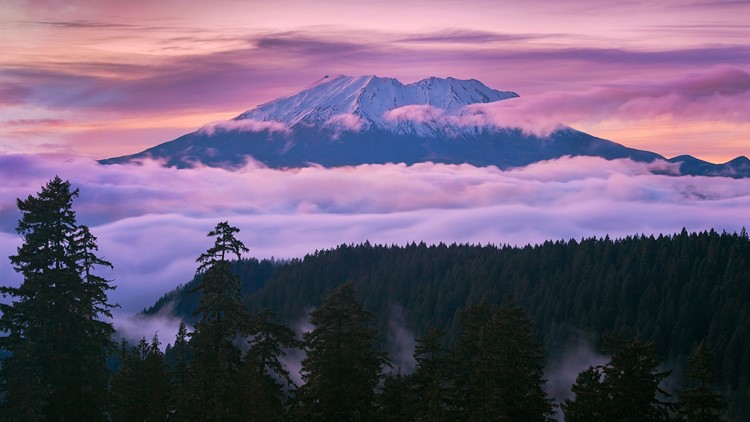Four dozen earthquakes were detected at Mount St. Helens over the last month, but volcano seismologist Dr. Weston Thelen of the United States Geological Survey said it’s nothing to worry about.
While the volcano alert level hasn’t been raised, the swarm of activity is a reminder that Mount St. Helens is the most active volcano in the Cascade Range. It was the last to erupt, and likely also the next to erupt.
“This is not a sign that an eruption is coming. These are small earthquakes located right above where we think the magma chamber is, it may mean magma is moving around, feeding into the chamber,” said Thelen.
“If they were larger or there were hundreds per day, that might cause a change to the alert level,” said Dr. Seth Moran, scientist-in-charge at the Cascades Volcano Observatory. “The two eruptions that we’ve watched happen both started with an incredible change in activity.”
Mount St. Helens last erupted from 2004 to 2008. Swarms of small earthquakes have happened several times a year in the decade since. These quakes are mostly between magnitude zero and one. Thelen explained that small quakes are detected because of the intensive monitoring at Mount St. Helens.
“The reason we have that dense array is because Mount St. Helens is more active than the other Cascade volcanoes. But even if you’re hiking on the rim, you wouldn’t feel these small earthquakes happening three or four miles below the surface,” Thelen said.
Part of the Pacific Ring of Fire, the Cascade Volcanic Arc spans over 700 miles, extending from northern California to British Columbia. The arc includes Mount St. Helens, Glacier Peak, the second most active in the region, and Mount Rainier, among others.
When Mount St. Helens erupted explosively on May 19, 1980, it was the first-time scientists witnessed what’s called a “lateral blast,” or an eruption that blows out the side of the volcano rather than the top. While earthquakes had alerted scientists that an eruption was coming, the surprising lateral blast resulted in 57 deaths and widespread damage, making it the deadliest volcanic eruption in United States history.
Mount Rainier is much less active by contrast, averaging about one earthquake per week. The last eruption from Mount Rainier is in dispute, but Thelen said it was probably about 1,000 years ago.
The bigger threat from Mount Rainier is lahars, a slurry of rock, water, clay, and mud that flows down into the surrounding lowlands at high speeds. The last major lahar to come down from Mount Rainier was about 500 years ago and was not accompanied by any major eruption. Dubbed the Electron Mudflow, the lahar traveled 62 miles and was almost 100 feet deep when it reached the town of Electron in the Puget Sound lowlands.
Sulfur gas, water, and ice contribute to weathering and weakening of the volcanic rocks at the top of Mount Rainier.
“We know from remote sensing that there are weak rocks high up on the west side,” said Thelen. “We have begun to upgrade lahar detection and hope to let the people downstream know with enough time to get out of the way.”
Thelen explained that seismometers and trip-wires are used to detect the start of a lahar and get a warning to communities downstream, but they were always looking for ways to improve detection speed.
“We’re trying to install instruments higher up to give more warning. As it is, it would take some time for lahars to reach the trip wires. If we could get instruments higher up, we might add minutes to the warning,” Thelen added.
When asked why Mount St. Helens is more active than the other Cascade volcanoes, Thelen was candid.
“We don’t really know why… but looking at the volcanic history, we see that it’s been very active over the past 10,000 years. The current cone didn’t even exist when the pyramids were built," Thelen said.



